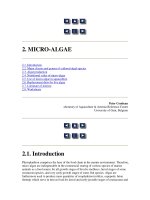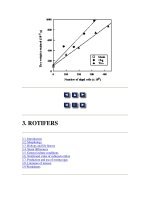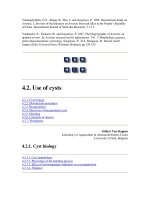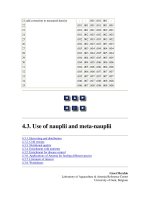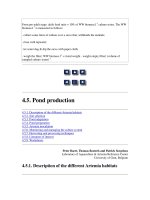On the predictability and resilience of gold prices’ returns and volatility
Bạn đang xem bản rút gọn của tài liệu. Xem và tải ngay bản đầy đủ của tài liệu tại đây (388.36 KB, 10 trang )
Journal of Applied Finance & Banking, vol. 6, no. 6, 2016, 23-32
ISSN: 1792-6580 (print version), 1792-6599 (online)
Scienpress Ltd, 2016
On the Predictability and Resilience of
Gold Prices’ Returns and Volatility
John Francis T. Diaz1
Abstract
Utilizing forty-five years of daily London gold price fixes, this paper finds the
presence of dual long-memory processes in the 10:30am fix and the 3:00pm price
fix utilizing ARFIMA-FIGARCH and ARFIMA-FIEGARCH models,
respectively. This research proves that the return and volatility of the London
Gold price fixes have predictable structures and does not conform to the weakform efficient assumption of Fama (1970). This study also suggests that the
London gold price fixes do not exhibit leverage effects and asymmetric volatility
response properties. This means that gold as an investment is generally immune to
negative shocks, proving the resilience of gold as financial instrument. This paper
also reveals the ARFIMA-FIAPARCH models have better fit in modeling the
morning gold fix, while the ARFIMA-FIEGARCH model is more suitable in
modeling the afternoon gold fix.
JEL classification numbers: G10, G12
Keywords: long-memory and asymmetry, fractionally-integrated models,
London Gold price fix returns and volatilities.
1 Introduction
Historically, gold has been perceived by investors as a safe-haven asset
expected to retain or even increase its value in periods of stock market declines
and recession. Gold as an investment is sought to minimize exposure to huge
losses and hedge against risks. However, this reputation is being challenged in
recent history, because gold is experiencing the biggest sell off in the last three
1
Department of Finance and Department of Accounting, College of Business, Chung Yuan
Christian University, Taiwan
Article Info: Received : Mayt 24, 2016. Revised : June 26, 2016.
Published online : November 1, 2016
24
John Francis T. Diaz
decades. The dramatic fall in gold prices is being perceived as a bubble deflation
caused by more speculative share-dealing bets, which helped in boosting the
volatility of gold prices.
The London gold fix mechanism determines gold prices. Value fixing is done
twice each business day, first at 10:30am or the morning fix; and second at
3:00pm or the afternoon fix. This determined price is utilized by 1) large gold
owners like refineries and mining companies and central banks; 2) retailers like
coin dealers and jewelry manufacturers; and 3) derivatives markets like futures,
swaps and options. This mechanism fixes a gold price to settle contracts between
members of the London bullion market, and to provide a recognized rate as a
benchmark for pricing gold products and derivatives around the world. Most gold
producers and refiners sell using the afternoon fix, because it is timelier in their
business hours and reflects market conditions more due to its liquidity, and
because Asia and North American markets are closed during the morning fix.
Comprehending return and volatility characteristics of gold is crucial because
the persistent changes in their structure as an investment can expose both hedgers
and speculators to risks. Traders and investors noticed that the London gold
10:30am fix is generally higher than the 3:00pm fix, thus, a possible difference in
the long-memory and asymmetric volatility properties of the morning and
afternoon gold fix prices can be possible. The prediction of gold’s return and
volatility has attracted greater interest to investors and researchers recently
because of its longstanding reputation of stability is being rigged. The notion that
whether or not gold is still a resilient investment and much more predictable have
been more relevant in the recent times. This study plans to capture these
tendencies through determining the long-memory process and asymmetric
volatility property of gold fix prices.
Long-memory process models the presence of a persistent positive
dependence among distant observations, which suggests the predictability of gold
prices’ time-series in returns and volatility. On the other hand, the asymmetric
volatility property of gold prices describes the negative correlation between
returns and changes in volatility. This process is connected to the leverage effects
property, wherein negative shocks often result to future higher volatility rather
than positive shocks. These nonlinear processes perfectly test whether gold fix
prices is still efficient and resilient to shocks. The literature of gold time-series
was studied by Frank and Stengos (1989), Yang and Brorsen (1993), and Habibnia
(2010), and all agreed on the existence of nonlinear deterministic process in its
structure. Cheung and Lai (1993) studied the predictable behavior of gold during
the post-Bretton Woods period, and found that long-memory property of gold
returns is unstable, and with few observations used little evidence of long-memory
can be found. In a more recent set of studies, Wang et al. (2007) proved that the
prediction of gold prices is possible given the proper modeling to forecast the
relative error of the utilized GM and Markov chain. This was also proven by
Ismael et al. (2009) by using the multiple regression method, and suggested
macroeconomic variables to predict gold prices. On the resilience of gold as
On the Predictability and Resilience of…
25
investments, Baur and Lucey (2010) find that gold is a good hedge against stocks,
and a safe haven in extreme stock market conditions. A related study of Baur and
McDermott (2010) showed a particular example wherein gold has reduced losses
in the peak of the recent financial crisis.
The study is motivated by the recent surge in the application of
fractionally-integrated long-memory and asymmetric volatility models in financial
time-series. This research is also motivated in adding to the literature of gold
prices returns and volatility, particularly statistically establishing its predictable
and resilient properties as an investment. This research contributes to the literature
by comparing four combinations of fractionally-integrated models, a) ARFIMA, b)
ARFIMA-FIGARCH, c) ARFIMA-FIAPARCH, and d) ARFIMA-FIEGARCH in
examining long-term positive dependence, asymmetry and leverage effects in the
returns and volatility of London gold fix price returns. In relation with the
motivation and contributions, this paper differs from the previous studies through
these four main objectives:
a) identify which type of models are better to characterize future values using
lagged returns to determine the time-series of morning and afternoon gold fixes;
b) find out positive long-term dependence in the time-series of gold fix
prices, and examine the dual long-memory process in their returns and volatilities;
c) determine differences in the characteristics of the 10:30am and 3:00pm
price fixes with regards to their short-, intermediate-, and long-memory processes;
d) challenge the basic assumptions of the EMH of Fama (1970), because the
presence of high-order positive correlations make predictions on future returns
possible
The research is written as follows. Section 2 explains the data and the four
fractional integration models applied; Section 3 presents the empirical results;
and Section 4 gives the conclusion.
2 Data and Methodology
This research analyzes daily closing prices of the London Gold fix from the
Federal Reserve Bank of St. Louis database from April 2, 1968 to May 16, 2013.
The 10:30 morning fix has a total of 11,387 observations, and the 3:00 afternoon
fix has a total of 11,256 data points. The difference in the number of observations
is the absence of gold fix price on certain dates. The series of returns were
computed as, yt 100(log pt log pt 1 ), where pt represents the price at time t. The
financial time-series data were modeled by ARFIMA-FIGARCH, ARFIMAFIEGARCH and ARFIMA-FIAPARCH processes and are explained below.
The ARFIMA model as proposed by Granger and Joyeux (1980) and
Hosking (1981) provides the first testing of the long-memory property of timeseries data. The model introduces the difference parameter (d) as a non-integer
26
John Francis T. Diaz
and suggests the fractionally integrated process I (d ) in the conditional mean. The
ARFIMA ( p, d , q ) model satisfies both stationary and invariability conditions and
can be written as:
( L)(1 L) d ( X t ) ( L) t ,
t zt
(1)
zt ~ N (0.1) ,
t'
where d represents a fractional integration real number parameter, denotes the
conditional mean, L corresponds to the lag operator and t represents a white
noise residual. The (1 L) d denotes the fractional differencing lag operator. The
AR and the MA processes are assumed to have all roots outside the unit circle, and
can be shown as ( L) 1 1L 2 L2 ... P Lp
and ( L) 1 1L 2 L2 ... P Lp , respectively.
The ARFIMA model is assumed to be stationary when 0.5 d 0.5 ,
where the effect of shocks to t decays at a gradual rate to zero. Also, the model
has a short memory when d = 0, where the effect of shocks decays geometrically;
and a unit root process is exhibited when d=1. The model has a long-memory
process or has positive dependence among distant observations when 0 < d < 0.5;
and is also consistent to an intermediate memory or has antipersistent property
when -0.5 < d < 0. Moreover, the ARFIMA model becomes non-stationary when
d 0.5 ; and stationary but a noninvertible process when d 0.5 , which makes
the data time-series impossible to model by any AR process.
The FIGARCH model as proposed by Baillie et al. (1996) improves the
traditional GARCH model allows the distinguishing parameter (d) to be a noninteger, which accounts the fractional integration in the model. The FIGARCH
process also offers flexibility by capturing short-, intermediate- and long-memory
in the volatility of financial time-series. The FIGARCH ( p, d , q ) model can be
expressed as:
(L)(1 L)
d
2
t
[1 ( L)]( t2 t2 ) ,
(2)
where d denotes a fractional integration parameter, L corresponds to the lag
operator and t denotes a white noise residual process. The FIGARCH model
assumes a long-memory process when 0 d 1 allowing more flexibility in
modeling the conditional variance; (1 L) d represents the fractional differencing
operator; and (L) denotes an infinite summation which, has to be truncated. The
FIGARCH process is reduced to the GARCH model when d 0 .
The FIEGARCH model as proposed by Baillie et al. (1996) extends the
EGARCH model, which also determines long-memory in the conditional variance.
27
On the Predictability and Resilience of…
Similar to the EGARCH, the FIEGARCH model can also capture volatility
asymmetry found in the financial time-series. The FIEGARCH ( p, d , q ) model
can be expanded as follows:
yt t t ,
(1 L)(1 L)d log( t2 ) g ( t 1 ) ,
(3)
where d represents the fractional integration parameter which captures the longmemory property when 0 d 1 . A significant negative parameter theta ( )
measures the leverage effect, which signifies strong volatility persistence, while
2
g ( t ) ( t
) t and t is a Gaussian white noise with variance 1. The
FIEGARCH model can become the short-memory EGARCH model of Nelson
(1991) when d 0 ; and the process is stationary if 1 and d 0.5.
The FIAPARCH model as proposed by Tse (1998) captures volatility
asymmetry aside from the long memory feature in the conditional variance. The
model is seen to be superior than the FIGARCH process through the improvement
in volatility with the function t t and can be expressed as follows:
t 1 ( L)1 1 1 ( L)1 ( L)(1 L) d ( t t ) ,
(4)
where d represents the fractional integration parameter, and gamma ( ) denotes
the asymmetry model parameter. The FIAPARCH model has a long-memory
process when 0 < d < 1. The model shows that negative shocks have more impact
on volatility than positive shocks when > 0, and the inverse is also the same.
The FIAPARCH process can be also reduced to the FIGARCH model if = 0 and
= 2.
3 Empirical Results
Table 1 shows that the London gold fix prices have positive returns with the
10:30am fix slightly higher with 0.013 than the 3:00pm fix with 0.012. The
morning fix is also more volatile with 0.562 compared to 0.545 of the afternoon
fix. The research concludes that the Modern Portfolio Theory of Markowitz
(1952), stating that a higher risk is compensated with higher returns is consistent
with the London gold fix time-series. Both gold fix returns are positively skewed
and have leptokurtic distributions. The Jarque-Bera statistic for residual normality
shows that the gold fix returns are under a non-normal distribution assumption.
28
John Francis T. Diaz
Table 2 illustrates the use of Augmented Dickey-Fuller test to examine the
stationarity of the London gold morning and afternoon price fixes, and the
minimum value of the Akaike Information Criterion to identify the orders of the
models. Both the 10:30am and 3:00pm return samples have no serial correlation,
based on the results of the Lagrange Multiplier (LM) test. This paper used the
ARCH-LM process to test the ARCH effect and eliminate heteroscedasticity in the
volatility of the data, the test also illustrates that the GARCH models can be
applied in the both the morning and afternoon fixes.
Table 3 shows the results for both ARFIMA and ARFIMA-FIGARCH
models. The ARFIMA model finds no significant results on the long-memory
structures of both the morning and afternoon price fixes. However the combined
ARFIMA-FIGARCH models find long-memory processes in the returns of the
10:30am fix with 0.029 value significant at the 10% level. This paper also finds
positive dependence the volatilities of both 10:30am fix with 0.521 value; and the
3:00pm fix with 0.489 value, both significant at the 1% level. This means that
return and volatility of the London Gold price fixes have predictable structures
and not a weak-form efficient financial time-series, which can signify a more
predictable structure particularly for the morning fix. The 10:30am gold fix is seen
to be steadier with less volatility caused by lower liquidity. These finding solidify
the initial observations of Cheung and Lai (1993), Wang et al. (2007) and Ismail et
al. (2009) in the predictable properties of gold. The log-likelihood value
consistently points to the combined ARFIMA-FIGARCH models as the best
fitting model to characterize the London Gold price fix compared to just
utilizing the ARFIMA model.
The ARFIMA-FIEGARCH and ARFIMA-FIAPARCH models are also
applied to confirm these initial findings and to add features of leverage effects and
asymmetric volatility properties, respectively. Table 4 shows that the two
models agree on the long-memory properties in the volatility of both the
morning and afternoon fixes. However, only the ARFIMA-FIEGARCH models
find positive dependence on the return of the 3:00pm price fix, which signifies
dual long-memory in both returns and volatilities of the afternoon fix.
This research also discovers that the London Gold price fixes do not exhibit
leverage effects with the significant positive value of the theta ( ) parameter.
This is clearly supported by the negative gamma ( ) coefficients, which means
that asymmetric volatility response to shocks is not present. This paper found that
positive and negative news has the same magnitude and proves the resilience of
gold as investment instrument. These findings are consistent to the initial claims
of Baur and Lucey (2010) Baur and McDermott (2010) on the resistance of gold to
extreme shocks and its safe haven property. This research used the highest loglikelihood values to identify the best fitting model. This study finds that the
combination of the ARFIMA-FIAPARCH models are better in characterizing the
On the Predictability and Resilience of…
29
morning gold fix, while the ARFIMA-FIEGARCH model is more suitable in
modeling the afternoon gold fix. This paper provides technical evidence on gold’s
predictable property, and supports the old reputation of gold as a safe haven,
which suggests that hedgers and speculators can depend on the resilience of gold
as an investment to external shocks.
4 Conclusion
Identifying the gold price’s predictability through the long-memory
process, and resilience through the asymmetric volatility and leverage effects
properties in returns and volatilities have long been a great interest for traders and
investors. The combined ARFIMA-FIGARCH models find long-memory
processes in the returns of the 10:30am fix, while the ARFIMA-FIEGARCH
models find the same results on the return of the 3:00pm price fix. All
fractionally-integrated models in the conditional variance agree on the long
memory properties in the volatility of both the morning and afternoon fixes. This
study also concludes that dual long-memory processes are present on the 10:30am
fix and the 3:00pm price fix using ARFIMA-FIGARCH and ARFIMAFIEGARCH, respectively. These initial results mean that return and volatility of
the London Gold price fixes have predictable structures and does not conform to
the weak-form efficient assumption of Fama (1970). Traders expect to experience
abnormal returns given the right forecast modeling that they will employ. Using
the highest log-likelihood values, this study finds the ARFIMA-FIAPARCH
models to better characterize the morning gold fix, while the ARFIMAFIEGARCH model is more suitable in modeling the afternoon gold fix. This
paper also reveals that the London gold price fixes do not exhibit leverage effects
and asymmetric volatility response, which means that negative shocks have
similar effects with positive shocks contrary to most investments. The paper
proves the resilience of gold as financial instrument, which suggests that investors
can depend on the long-term viability of gold against external shocks.
References
[1] Baillie, R. (1996) Long memory processes and fractional integration in
econometrics. Journal of Econometrics, 7, 35-59.
[2] Baillie R., Bollerslev T. and Mikkelsen H. (1996) Fractionally integrated
generalized autoregressive conditional heteroskedasticity, Journal of
Econometrics, 74, 3-30.
[3] Baur, D.G. and Lucey, B.M. (2010) Is gold a hedge or a safe haven? An
analysis of stocks, bonds and gold, Financial Review, 45(2), 217-229.
30
John Francis T. Diaz
[4] Baur, D.G. and McDermott, T.K. (2010) Is gold a safe haven? International
evidence, Journal of Banking and Finance, 34(8), 1886-1898.
[5] Cheung, Y.W. and Lai, K.S. (1993) Do gold market returns have long
memory?, The Financial Review, 28(2), 181-202.
[6] Granger, C. and Joyeux, R. (1980) An introduction to long memory time
series models and fractional differencing. Journal of Time Series Analysis,
1, 15-39.
[7] Hosking, J. (1981) Fractional differencing. Biometrika, 68, 165-176.
[8] Fama, E. (1970) Efficient capital markets: A review of theory and empirical
work, Journal of Finance, 2, 383-417.
[9] Frank, M. and Stengos, T. (1989) Measuring the strangeness of gold and
silver rates of returns, Rev. Econ. Statistics, 56, 553-567.
[10] Habibnia, A. (2010) Forecasting the world Gold price using optimized
neuro-fuzzy with Genetic algorithm and smooth transition regression with
long memory, SSRN working papers series 2010545.
[11] Ismail, Z., Yahya, A. and Shabri, A. (2009) Forecasting gold prices using
multiple linear regression method, American Journal of Applied Sciences,
6, 1509-1514.
[12] Markowitz, H. (1952) Portfolio selection, J. Financ., 7(1), 77-91.
[13] Tse Y. 1998. The conditional heteroscedasticity of the Yen-Dollar exchange
rate. Journal of Applied Econometrics, 13: 49-55.
[14] Yang, S., and Brorsen, B. W. (1993) Nonlinear dynamics of daily futures
prices: Conditional heteroskedasticity or chaos? Journal of Futures Markets,
13, 175-141.
[15] Wang, C.B., Chen, Y.H. and Li, L.H. (2007) The forecast of gold based on
GM (1,1) and Markov Chain, Grey Systems and Intelligent Services
Proceedings, 739-743.
31
On the Predictability and Resilience of…
Table 1: The Sample Size and Period of the London Gold price fixing
London Gold price fix returns
Morning London Gold Price Fix (10:30am)
Afternoon London Gold Price Fix (3:00pm)
Start of Data
April 2, 1968
April 2, 1968
Obs.
11,347
11,216
Mean
0.013
0.012
Std. Dev.
0.562
0.545
Skew.
0.056
0.062
Kurt.
13.471
10.949
J-Bera
85,805***
56,028***
Source: Yahoo Finance; />Note: *, ** and *** are significance at 10, 5 and 1% levels.
Table 2: Summary Statistics of ARMA and GARCH filtering
Gold fixes
10:30am
3:00pm
ADF
-111.743***
(0.000)
-61.017***
(0.000)
ARMA
(1,1)
AIC
1.684
(1,1)
1.625
LM test
1.353
(0.259)
1.852
(0.116)
Note: *, ** and *** are significance at 10, 5 and 1% levels, respectively; p-values are in parentheses.
ARCH-LM
691.898***
(0.000)
780.549***
(0.000)
GARCH
(1,1)
AIC
1.164
(2,2)
4.669
ARCH-LM
1.792
(0.167)
0.749
(0.473)
32
John Francis T. Diaz
Table 3: Summary Statistics of ARFIMA and ARFIMA-FIGARCH models
Gold fixes
10:30am
3:00pm
dARFIMA
0.011
(0.359)
0.018
(0.170)
ARFIMA
ARCH
AIC
(0,1)
1.683
loglikelihood
-9547.085
(1,2)
1.625
-9105.365
dARFIMA
0.029*
(0.076)
0.020
(0.258)
ARCH
(2,1)
(1,2)
ARFIMA-FIGARCH
dFIGARCH
0.521***
(0.000)
0.489***
(0.000)
AIC
1.143
loglikelihood
-6478.230
1.109
-6208.670
Note: *, ** and *** are significance at 10, 5 and 1% levels, respectively; p-values are in parentheses.
Table 4: Summary Statistics of ARFIMA-FIEGARCH and ARFIMA-FIAPARCH models
Gold fix
10:30am
3:00pm
dARFIMA
0.007
(0.793)
0.028*
(0.090)
ARCH
(1,2)
(2,2)
ARFIMA-FIEGARCH
dtheta
FIGARCH
0.477***
0.041***
(0.000)
(0.002)
0.560***
0.030***
(0.000)
(0.000)
AIC
1.140
loglikelihood
-6457.44
1.099
-6154.205
Note: *, ** and *** are significance at 10, 5 and 1% levels, respectively; p-values are in parentheses.
dARFIMA
0.007
(0.725)
0.014
(0.444)
ARCH
(2,1)
(2,2)
ARFIMA-FIAPARCH
dgamma
FIGARCH
0.467***
-0.127***
(0.000)
(0.000)
0.444***
-0.102***
(0.000)
(0.000)
AIC
1.129
loglikelihood
-6394.31
1.103
-6172.329


